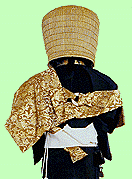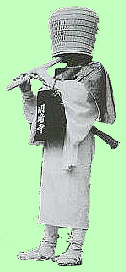DARUMA | You paint in right eye while making a wish, and when the wish has come true you paint in the other to express your gratitude |
 Click to enlarge
Click to enlarge |
Daruma dolls represent the Indian priest Bodhidharma(Daruma in Japanese), the founder of ZEN Buddhism in China, who is said to have lost the use of his arms and legs after spending nine years to get SATORI(spiritual awakening) in a cave.
Daruma dolls are usually made of papier-mache on a bamboo frame and consist of a bright red, rounded amalgam of head and body with two large spaces for eyes. They are used as charms for the fulfillment of some special wish or dreams.
You purchase one ,on such occasions as New Year Day, your birthday, and your anniversary. When candidates wish successful election to public office, Daruma dolla are indispensable in Japan. When you are making wish, you paint in one eye, and when the wish is fulfilled, you paint in the other. And for the next dream or wish, you should buy larger one
Prototypes of these dolls, called OKIAGARI-KOBOSHI("the little priest who stands up") because they return to an upright position when tipped over, were popular during the 16th century.
We have the proverb "nana(seven) korobi(fall down) ya(eight) oki(stand up) which means "never giving up" The present form of doll dates from the Edo period(1600-1868), when it was regarded as a talisman for protection against the evils.
Daruma are often sold in special daruma fairs(daruma-ichi), generally held in eastern Japan from the end of the year to the early spring |
Item No. and Height
hg8043-17cm(6.69in.)=1600-yen
hg8044-23cm(9.05in.)=2300-yen
hg10g-26cm(10.24in.)=3600-yen
hg12g-30cm(11.81in.)=5100-yen
hg14g-36cm(1ft2.17in.)=7800-yen |
| | | | |
|
KOMUSOU, SHAKUHACHI
and KESA | Komusou is the Buddhist priest belonglng to the Fuke sect of Zen Buddhism. They go on a pilgrimage playing long bamboo flutes with five finger holes,wearing a large braided hat which entirely covers the head. They visit each house along the way asking for alms of money,wearing a surplice around the neck and a sword at the waist. |
Click pictures to enlarge
|
KOMUSOU and SHAKUHACHI
Shakuhachi is the vertical bamboo flute with a notched mouthpiece and five finger holes.It takes its name from the standard length of the instrument in traditional measuring units,1 shaku, 8 sun, or 54.5 centimeters(21.46 in). The Shakuhachi is made from madake bamboo(Phyllostachys bambusoides). The bamboo is severed near the root, which becomes the bell of the instrument. Four finger holes are placed equidistant on the front face, with an upper thumb hole on the rear face, and the inner bore is lacquered. Imported from China with other imperial court instruments, the shakuhachi first appeared in Japan in the late 7th century. This early shakuhachi with six finger holes in the Chinese manner, was a regular member of the Japanese court orchestra(GAGAKU)until the end of the 9th century. Occasional historical references to the shakuhachi continue to appear throughout the Kamakura(1185−1333)and Muromachi(1333−1568)periods,but when and how the six-hole form gave way to the five-hole instrument is unclear.In the early 16th century, the shakuhachi began its association with the wandering beggars called komosou("straw-mat priests").In the 17th century, the players became known as komusou. The komusou comprised a sect of Zen Buddhism ca11ed the Fuke sect,the theoretical basis of which was the playing of shakuhachi as spiritual discipline. They claimed legitimacy by tracing their origins to the 9th century Chinese priest Fuke(Ch:Puhua or P'u-hua).The Fuke sect was granted official recognition by the government in the 17th century, and licensed komusou were given the exclusive right to play the shakuhachi. The Zen practice of playing shakuhachi was maintained throughout the Edo period and even after the abolition of the Fuke sect by the new Meiji government in 1871.Many performers encouraged the development of the shakuhachi as a secular instrument, while others strove to revitalize the Zen tradition with its unique repertoire of spiritually oriented solo pieces (honkyoku). Of the various schools that developed, the Myoan, Kinko, and Tozan schools are the best known.The Myoan represents the original Zen ideals of the Fuke sect; the Kinko descends from the 18th century but developed in later years with stylistic influence from koto and shamisen music;and the Tozan, founded in 1896, signals a new departure under the influence of Western music. |
KESA (Buddhist Surplice)
 |
KESA (Buddhist Surplice)
Buddhist followers were only allowed to have limited possessions referred to as "three robes and one bowl." This clothing , called "funzoe", were items cast aside at the roadside or the graveyard or things which they received from others. That was all they were allowed to wear.
They covered themselves in clothing made from scraps they picked up on the streets or cemeteries. The Indian word for this was kasaya, meaning of "mixed colors" The word comes down to us today as the translation Kesa.
Later, when the Buddhist order fragmented, the various groups took on their own colorings and forms. As a result, the surplice gradually become more colorful, and depending on the ceremonial use and the sect, they have become more complex and gorgeous. In present-day Japan, the color and the shape differ with the position of the priest who wears it, and there are different surplices for each ceremony.
|






